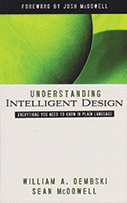Return to 4th Quarter 2019 articles.

Understanding Intelligent Design
by William Dembski & Sean McDowell, Harvest House Publishers, © 2008,
233 pages, $14.99 (paperback), ISBN-13: 978-0-7369-2442-9

“Darwinism has run its course. Design is now revolutionizing the way we see the world, much as Darwinism did more than a century ago.” That statement near the end of the book (page 172) is perhaps the best one-sentence summary of this book. For more than 50 years, the Does God Exist? ministry has pointed out the evidence that there is design in the creation. The Bible makes it clear that we can know there is a God through the things he has made (Romans 1:20), that we can see wisdom in the creation (Proverbs 8), and that the “The heavens declare the glory of God; and the skies proclaim the work of his hands” (Psalm 19:1). We can all understand these statements as can any child.
As America has veered off into atheism, science has promoted naturalism as good science while claiming that all other views should not be considered. Many reputable scientists have rebelled against these anti-religious views. We have presented some of the rebels in this journal, including John Lennox, Henry Schaefer, Alister McGrath, Gerald Schroeder, Michael Behe, and Francis Collins. Perhaps the most vocal and most published of these is William Dembski, who authored this book with Sean McDowell.
This is the best book we have seen on Intelligent Design. McDowell's presence makes the book easy to read and understand. Dembski is very thorough, technical, and knowledgable. The first two chapters show the bias in the academic community. Much of mainstream science refuses to consider evidence that clearly shows the assumptions of naturalism are false. The book contains quotes from atheists, evolutionists, naturalists, and media people documenting the closed-minded nature of the academic scientific world today. The last three pages of the book encourage the reader to get active in forming intelligent design promotion groups locally and nationally.
This book promotes the concept of design well, shows the weaknesses of Darwinism, and answers a vast percentage of atheist challenges. It is not so technically loaded that you get lost in the explanations, so high school students should be able to read and understand it. It has a useful index and five appendices with resources and supplements. There are also guides available for class use (see our book review on “Introduction to Intelligent Design”). We recommend this book very highly.
